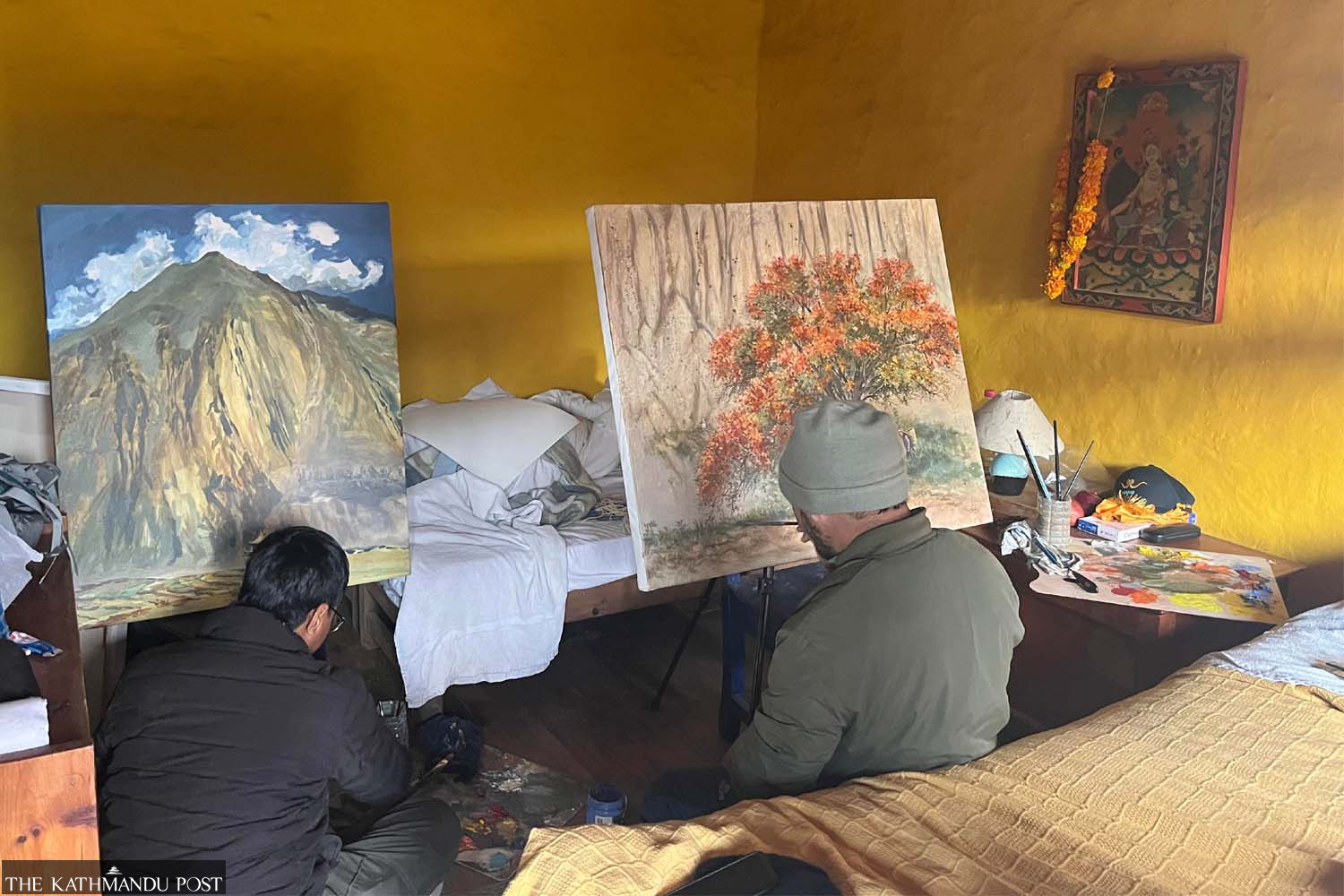Arts
The first IMAF in Mustang brings painters together
In the International Mountain Art Festival, artists shared their love for nature, culture, and creativity while promoting the region as a tourist destination.
Ellie Davis
Though born in Manaslu, India, and raised in Chitwan, Nepal, artist Dhwoj Gurung chose to base his career in Mustang, painting landscapes and architecture.
Now, for the first time, the International Mountain Art Festival has brought artists from around the world—Thailand, Poland, Romania, Bhutan, Indonesia, and Taiwan—to Mustang to capture the same beauty.
“Sharing is beautiful, especially among artists,” Dhwoj says. “I know all of the locations, culture and people, so sharing with other artists is a beautiful feeling.”
Tripple P Gurung, a former pilot and Jomsom hotel owner, has been planning the week-long IMAF since June with the help of his friends and colleagues. In addition to painting, the festival, which concluded on Thursday, featured sound healing, fossil hunting, and traditional dances.
For years, Tripple P has organised gatherings of Nepali artists in Mustang, but he wanted to go bigger by bringing in artists from around the world.
“The whole idea of this is to promote a destination through art and at the same time give a platform to the artists,” he says.
Originally from Manang, Tripple P saw his community’s economy suffer due to a lack of tourism during the Maoist insurgency. With a background in marketing, he has worked for decades to promote Mustang as a tourist destination.
“My village is all dependent on tourism,” he says. “If there are no tourists, the economy will be bad.” While in Mustang, the 16 painters—nine Nepal-based and seven international—who gathered in Kagbeni had the opportunity to focus solely on their work while drawing inspiration from fellow painters.
Kathmandu-based artist Shreejan Rajbhandari came to Mustang once before, 25 years ago, to go trekking with friends, but he didn’t have the opportunity to paint.
“It was my dream to come here again, and this is a great opportunity to work with fellow artists,” Rajbhandari says. In addition to producing his work, he learned from the other artists’ techniques at the IMAF.
“Artists from different places have their style and are influenced by their land and culture,” Rajbhandari says. “I can see their perceptions of nature–their colour and composition choices.”
Thailand-based artists Direk Kingnok and Ekaraj Ohn experienced Mustang for the first time during the festival. “Thailand has a hot climate, which is very different from here,” Ohn says. “I’ve never seen (this region) before in my life; it inspires us.”
With 15 years of experience in Mustang, Dhwoj Gurung has, in part, focused on the threat to village life in his work as an artist. He has taken a particular interest in painting the architecture of Mustang because heavy rainfall associated with climate change threatens the mud-based construction materials that hold up many of the buildings in Mustang’s villages. “I’m a little bit afraid we might not be able to see these beautiful buildings in the next generation,” he says. “I’m trying to convey documentation through my paintings.”
Kathmandu-based artist Wang Lama also tries to preserve stories through his art. Lama is originally from Humla, Nepal, though his recent exhibition in Kathmandu, titled ‘In Search of Vanishing Identities’, displayed many paintings from Mustang. One of the paintings that he produced at the IMAF captured a nearby apricot tree from the valley surrounding Kagbeni.

“Because of globalisation and market demands, people are planting more apples, but before [apricots] were local food for local people,” he says. “I want to spread the message of the importance of our traditional life.”
In addition to live, outdoor painting in Kagbeni, the IMAF hosted the Travelling Kathmandu International Mountain Film Festival for four consecutive nights in Jomsom. Festival Director Ramyata Limbu says the KIMFF has travelled to more than 50 districts across Nepal but never to Mustang or another mountain region due to costs and challenging logistics.
Limbu, married to Tripple P Gurung, appreciated the screening of films among a gathering of artists. “Artists, filmmakers, dancers, and creative people are all ambassadors for their respective cultures,” she says.
On the opening night of screenings in Jomsom, attendees watched three short films. The first film, ‘Dhye Dreams’, focuses on the story of three women in the village of Dhye in Upper Mustang, only three hours north of the film’s screening.
“It’s very important to me that the film is shown to the people from this area,” Director Shanta Nepali says. “I want to show people their own experience.”

Gurung intends to host a similar event next year and establish the IMAF as an annual tradition in Mustang. “I’m doing this to promote this place, the mountain visit,” he says. “When anything is empty, even in a beautiful place, you can feel it.”
Even though the artists who gathered in Mustang came from many different places, they found commonalities between their cultures and communities in their shared passion for art.
Emmy Go, who travelled from the island of Papua in East Indonesia for the IMAF, said that Nepal and Mustang were unlike any other place she had been. “It’s a dream country, like a little heaven in the world,” she says.
Despite the distance from her home, among a community of artists, Go found similarities between her home country and Nepal. She notes that the ammonite fossils in the Mustang region were the same as her home, and the ladders leading from the courtyard to the roof were constructed the same.
Rajbhandari wasn’t surprised by the group’s ability to find commonalities across cultures. “There is a mutual understanding between the artists,” he says.




 18.37°C Kathmandu
18.37°C Kathmandu










